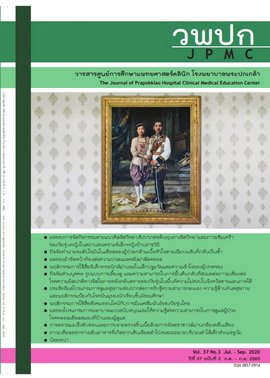Impact of Belly Band on Pain after Cesarean Section
Main Article Content
Abstract
Background: New mothers tend to experience post-operative surgical pain, especially within the first 24 hours after giving birth. This pain can torture post-cesarean section mothers, which may cause an inability to ambulate and increase post-operative complications.
Objectives: To investigate the impact of using a girdle to reduce pain
Methods: To achieve this goal, 40 mothers who were admitted to Naresuan University Hospital and had just given birth to a baby were recruited for the experiment and divided into either an experimental group (20) or control group (20). Data was collected between January and November, 2019. Data collection was accomplished using a cesarean pain assessment form. Comparison was carried out between the experimental group, who used a belly band, and the control group, who did not use a belly band. The results were analyzed using descriptive statistics, Chi-squared test or Fisher's exact test, Independence t-test and Mann-Whitney Test.
Results: The results showed that the average post-operative pain scores for the experimental group were lower than those of the control group, though they did not reach the level of statistical significance (p = 0.35). The experimental group had a mean score obtained from the pain trial of 2.8 ±2.1 points, while the control group had a mean score of 3.5 ±2.1 points.
Conclusion: From this research, it is suggested that the belly band should be utilized together with other methods, such as herbal compress or cold compress, to increase the effectiveness of curing pain after cesarean section.
Article Details
References
Betran AP, Torloni MR, Zhang JJ, Gulmezoglu AM. WHO Statement on cesarean section rates. BJOG 2016;123:667–70.
Inthawiwat S, Laivechpittaya S. Cesarean delivery. in: Piyaanan M, Wantanasiri C, Sansaneewittayakul P, Editor. Modern textbook of obstetrics. Bangkok: Department of Obstetrics and Gynecology, Faculty of Medicine Siriraj Hospital; 2005. Page 177-81.
Kintu A, Abdulla S, Lubikire A, Nabukenya MT, Igaga E, Bulamba F, et al. Postoperative pain after cesarean section: assessment and management in a tertiary hospital in a low income country. BMC Health Serv Res2019;19:68.
Parsons G. Preece W. Principles and practice of managing pain: aguide for nurses and allied health professionals: New York: Parsons and Preece; 2010.
Melzack R, Wall P.D. Pain mechanisms: a new theory. Science1965;150(3699):971-9.
Murray S.S, McKinney ES. Foundations of maternal-newborn and women’s health nursing. .5th ed. Maryland Heights: Saunders Elsevier; 2010. p. 390-420.
Eshkevari L, Trout KK, Damore J. Management of postpartum pain. J Midwifery Women Health 2013;58:622-31.
Pinchaleaw D, Bhoosahas P. Factors related to women’s distress after cesarean section. Journal of The Royal Thai Army Nurses 2020;16(1):101-8.
Jin J, Peng L, Chen Q, Zhang D, Ren L, Qin P, et al. Prevalence and risk factors for chronic pain following cesarean section: A prospective study. BMC Anesthesiology [Internet]. 2016 [cited2019 Dec 15];16. Available from: https://www.ncbi.nlm.nih.gov/pmc/articles/PMC5069795/
Azari L, Santoso JT, Osborne SE. Optimal pain management in total abdominal hysterectomy. ObstetGynecolSurv2013;68:215-27.
Karlstrom A, Engstrom-Olofsson.R, Norbergh KG, Sjoling M, Hildingsson I. Postoperative pain after cesarean birth affects breastfeeding and infant care. JObstetGynecol Neonatal Nurs2007;36:430-40.
Hahn-Holbrook J, Schetter CD, Haselton M. Breastfeeding and maternal mental and physical health. In: Spiers MV, Geller PA, Kloss JD, editors. Women’s health psychology. New Jersey: Jhon Wiley & Sons; 2013. P 414-39.
Irvine D, Sidani S, Hall LM. Linking outcomes to nurse’s roles in health care. Nurs Econ 1998;16(2):58-64,87.
Sunthornkulwong M, Kimsungnoen N, Namjuntra R. Quality of postoperative pain management in women after cesarean section under general anesthesia. Journal of Nursing Science &Health2018;41(4):96-104.
Saowaros C. To follow Thai wisdom towards the new generation: Thai wisdom in caring for postpartum mothers’ health. J PrapokklaoHospClin Med Educat Center. 2019;36(3):251–57.
Lohitthai S, Tongkoop B. The effect of cold compress belly band on cesarean incision pain among post-cesarean section delivered mothers. The Journal of Faculty of Nursing Burapha University. 2019;27(1):23-32.
Gustafson JL, Dong F, Dong F, Duong J, Kuhlmann ZC. Elastic abdominal binders reduce cesarean pain postoperatively: a randomized controlled pilot trial. Kans J Med2018;11:48-53.
Ghana S, Hakimi S, Mirghafourvand M, Abbasalizadeh F, Behnampour N. The effects of abdominal binder on wound healing and consumed pain medications after cesarean section: A randomized control trial. Iran Red Crescent Med J[Internet]. 2017[ cited 2019 Aug 26];19(4):e44119.Available form: https://sites.kowsarpub.com/ircmj/articles/13189.html
Gillier CM, Sparks JR, Kriner R, Anasti JN. A randomized controlled trial of abdominal binders for the management of postoperative pain and distress after cesarean delivery. Int J GynaecolObstet 2016;133):188-191.
Kusuwan N. An effect of using Nuanjan Belly Band on comfort of women after caesarean section [Internet].2012[cited2017May1]. Availablefrom: http://www.gj.mahidol.ac.th/tech/FileDownload/File/D150511175633.pdf
Ngamjarus C, Chongsuvivatwong V, McNeil E. n4Studies: sample size calculations for an epidemiological study on a smart device. Siriraj Med J. 2016;68:160-70
Kolcaba KY. A theory of holistic comfort for nursing. J AdvNurs1994;19:1178-84.

